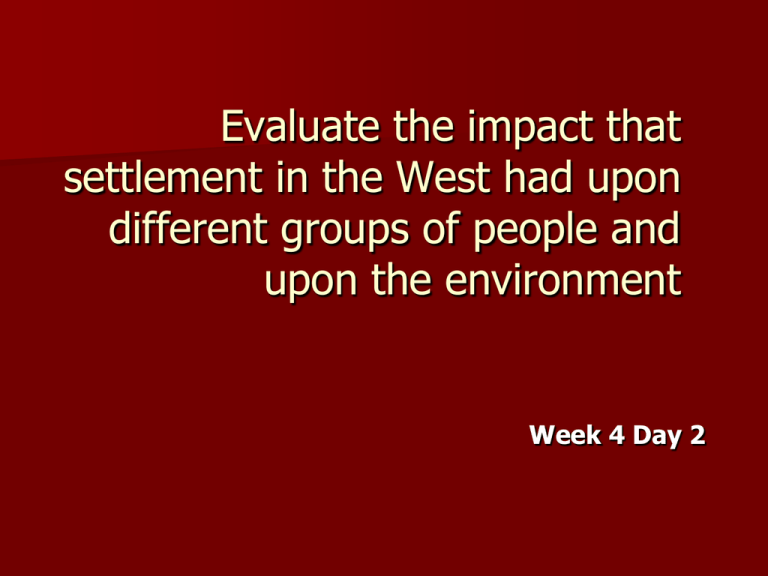Evaluate the impact that settlement in the West had upon different
advertisement

Evaluate the impact that settlement in the West had upon different groups of people and upon the environment Week 4 Day 2 Macro Concepts Migration-the mass movement of people from one place to another. Environment-Location affected by people, animals and weather. Status-Rank or level of a person based on wealth/education. Resources-Items that can be used for benefit or making things. Conflict-Problem or issue that is controversial and can cause problems with compromise. Micro Concepts Assimilation-The act of foreigners mixing/blending in with the existing population. Transcontinental Railroad and its Construction Train tracks were built across the entire United States from connecting West to East and North to South. Construction took place from the 1860s to 1910s. The work was very dangerous due to terrain [cliffs, valleys and mountains] weather [extreme heat and cold] and equipment used [dynamite]. Irish and Chinese immigrants were early laborers who roughed the harsh conditions for low wages. One of the most disgraceful events in U.S. history. Cheyenne and Arapaho Nation peoples were mostly friendly with U.S. citizens near their territories. In 1864 the U.S. Civil War was still being fought and Union armies were on high alert to threats. The Cheyenne Chief Black Kettle approached the U.S. Army Fort Lyon in Colorado. U.S. Army Colonel Chivington may have misunderstood or felt threatened by the Chief. The result was the slaughter and mutilation by the U.S. Army of over 100 Native Americans including women and children. Sand Creek Massacre Battle of Little Bighorn One of the most embarrassing defeats in U.S. Military history. During a patrol Lt. Colonel George Custer encountered a massive camp of Lakota and Cheyenne. Custer launched an attack in three directions underestimating the Natives. Custer and all of his troops but one were defeated and killed under the leadership of Lakota Chief Sitting Bull. Buffalo Soldiers One of the first all black army units in the United States. The 10th Cavalry Regiment was formed in 1866 to fight in the U.S. Civil War. The soldiers received their nickname from the Native tribes they fought. According to historians it was because of both their dark skin and dark curly hair that similar to the buffalo. Also the ferocity with which they fought. Wounded Knee Massacre The U.S. Government had banned the Ghost Dance for all Native tribes. The Ghost Dance was when Natives led by a Chief or spiritual leader would call the spirits to help them. The U.S. Government believed the dance threatened peace with the natives. On December 29, 1890 at Wounded Knee Creek, South Dakota over 150 Sioux were killed by U.S. Army troops after tried to disarm the Sioux during a ceremony. Chief Joseph and the Nez Perce Chief Joseph was the leader of the Nez Perce Nation located in what is now Oregon. U.S. Forces attempted to remove the Nez Perce Nation to a reservation in Idaho. His people refused and fought the U.S. Army. Under Joseph’s leadership the Nez Perce were able to resist by using effective military tactics. Eventually the Nez Perce fled to Canada to avoid U.S. Forces but later returned and accepted life on the reservation. Reservation System and the Dawes Act In 1891 Senator Henry Dawes led the passage of the Dawes Act [a.k.a. the Dawes Severalty Act] To solve the Indian Problem land was reserved [set aside] to remove from their lands. Vast areas called reservations were created to make room for American settlers. “Indians” were required to live on these reservations. Frederick Jackson Turner and Helen Hunt Jackson Two American authors who chronicled [wrote about] the effects of Western expansion were Frederick Jackson Turner and Helen Hunt Jackson. Turner explained that settlement of the Western Frontier was important but would lead to overseas expansion later on. Jackson wrote a book called A Century of Dishonor that criticized the injustice and mistreatment of NativeAmericans by the United States. Assignment: What if? After thinking about the events you learned involving Western Expansion you need to think about how things could have been different [you may make things better or worse]. Select one of the events/incidents that occurred and explain about how things could or should have been different. What if things happened differently? You can do one of the following: [a] 8-panel cartoon strip [b] diary entry [c] speech [d] newspaper/magazine article [e] poster/advertisement [f] foldable brochure IMAGE SOURCES http://en.wikipedia.org/wiki/File:Buffalo_soldiers1.jpg http://www.theworldwonders.com/industrial/railroad.jpg http://journeystories.org/plugins/ExhibitBuilder/ImageAudioVideoEmbeds/ChineseLaborer.jpg http://api.ning.com/files/*pK2zhilSFVU30hqX7sKsXrAQOIKYHRnArLsdSttZIBNl1QGxeKPIfeRgr95sekDsiPc6iCG2ktseJ9uubj33W7X5eW*0fJ/custerlasts tand1.jpg http://www.myimagezone.com/lib/Thumb.aspx?f=/data/0/82/82666.JPG&l=400 http://home.comcast.net/~zebrec/imgs/Ghost_dance.jpg http://www.believersministry.org/Partners/First%20Nations/ChiefJoseph5-500.jpg http://www.sonofthesouth.net/union-generals/sioux-indians/pictures/indian-village.jpg http://www.mpl.org/images/wall_turner.jpg http://www.coloradocollege.edu/library/SpecialCollections/Manuscript/HHJphoto1.jpg http://en.wikipedia.org/wiki/File:Chiving1.jpg http://upload.wikimedia.org/wikipedia/commons/0/03/Chief_Black_Kettle.jpg http://en.wikipedia.org/wiki/File:Sitting_Bull_2.jpg http://en.wikipedia.org/wiki/File:Chief_Joseph_and_family.JPG






